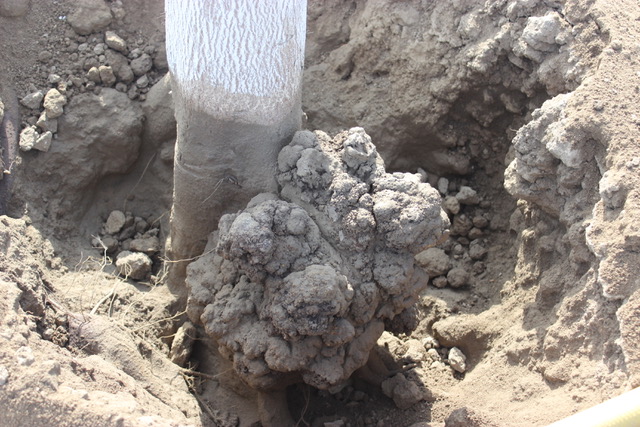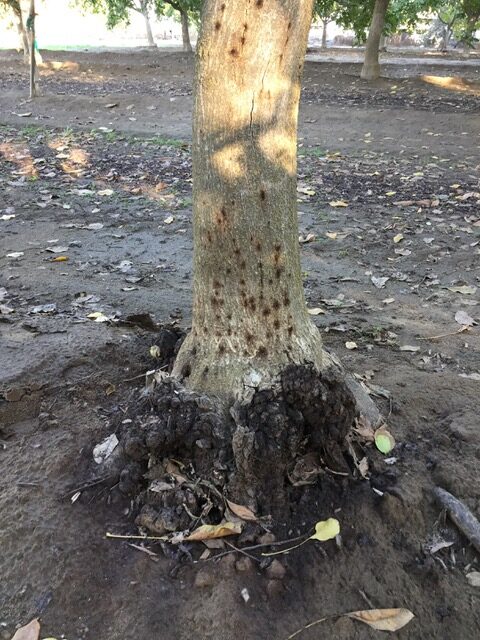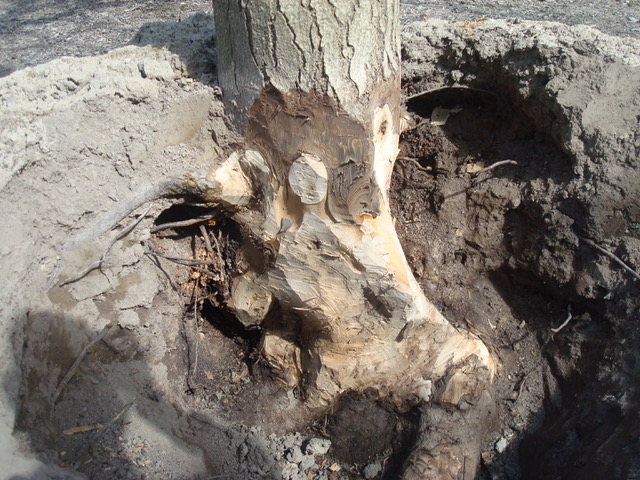
Crown gall can predispose a tree to future damage from pest and disease, reduce its longevity and lower yields throughout its life. And, according to USDA Agricultural Research Service plant pathologist Daniel Kluepfel, outside of labor-intensive, surgical control measures, once established, there are no remedies for it beyond direct replacement of the affected tree.
Crown gall, according to Kluepfel and Tulare County UCCE Farm Advisor Elizabeth Fichtner, is a huge problem for California’s walnut producers.
“It is a very big problem on seedling Paradox walnut rootstocks, which is the dominant rootstock in the southern San Joaquin Valley,” Fichtner said. “It is not unusual for 30% of the trees in an orchard to be affected by the pathogen.”
As the disease’s name implies, crown gall appears as abnormal tumors, or galls, on the crown or trunk of trees. But the name is a misnomer of sorts, Fichtner said, because it induces aerial galls on stems as well as galls on roots. Young trees that are infected become stunted, according to the UC IPM Pest Management Guidelines, while older trees often develop secondary wood rots. The disease is most damaging to trees that are between one and eight years old, according to the site.
The first management guideline listed on the UC IPM website is to plant noninfected trees. According to Kluepfel, this step starts in nurseries.
“When nurseries collect seeds, the seeds should never be allowed to contact the soil,” Kluepfel said, as the crown gall pathogen, Agrobacterium tumefaciens, survives in soil. Placing a tarp below trees when collecting hybrid seed can be an effective way to accomplish this, Fichtner said.
Even when taking extra steps to ensure trees are disease free at planting, however, a grower can’t be sure trees will get off to a disease-free start. “You could still plant them in pathogen infested soil,” Fichtner said. “In that situation, or if you use infested tools when you graft it, you could still get the disease.
“The pathogen is in nature,” she said.
Trees infected with the disease pathogen can live for years, Fichtner said, but it can benefit growers to take out infected trees and replant with uninfected trees, particularly if they spot the disease early in the life of a tree. At times, disease symptoms can be hard to spot, however.
“Sometimes you can’t tell whether the disease is there. It can be below the soil surface,” Fichtner said.

A Compounding Problem
The disease also is a “compounding problem,” according to Fichtner, because the stunted trees that are infected by crown gall receive more water per biomass than noninfected trees, leading to overwatering, exacerbating the stunting and creating additional problems.
“It will trigger other problems as well, making those trees harder to manage,” Fichtner said.
The most commonly asked question Fichtner fields about crown gall is where it came from. Unfortunately, she said, pinpointing its origins can be tricky given that the pathogen may have entered through infected nursery stock or through a wound created when pruning, grafting or conducting other cultural practices.
According to the IPM website, the most prominent method of pathogen introduction is from infected tools used for pruning or sucker removal. Tools can become infected through a variety of means, Fichtner said, including from coming in contact with infested soil or crown gall tumors.
One of the best control measures growers can employ, according to Fichtner, is to sanitize pruning tools, grafting knives and other tools between each tree. Sodium hypochlorite solution, or bleach, is an inexpensive yet effective disinfectant. She also noted that it is important to replenish a container with fresh solution to avoid the buildup of solids in a disinfectant.
Before planting, the IPM site advises growers to keep trees moist to prevent roots from drying out and to carefully handle trees to avoid injury, both at planting and during the life of the tree in the orchard.
Ian Hunter with Cure Soil Consulting believes correcting key deficiencies in the soil can have positive impacts on crown gall.
“Our work in grower trials has shown that improving soil biology succeeds in reducing crown gall pressure,” Hunter said. “By increasing the energetic state of the farm ecosystem through the addition of beneficial microorganisms within the soil, coupled with appropriate mineral balancing, we can mitigate disease in crops riddled with pathogens such as agrobacterium tumefaciens and return the tree to a state of elevated vigor.”
Preplant preventive dips are commercially available, but their effectiveness can vary, researchers said. And research has shown that the biocontrol agent, Agrobacterium radiobacter strain K-84, can effectively prevent crown gall, but again, Fichtner said, its efficacy can vary depending on pathogen population and environmental conditions. Also, the strain is only effective as a preventive treatment and does not eradicate galls. If using the product, use it as a spray before heeling in or planting, the IPM site notes. Also, Kluepfel said, growers should avoid using dip tanks as the method of K-84 inoculation.
Dr. John Bahme with AgBioChem, which markets K-84 under the Galltrol-A brand name, said timely application is important.
“The crown gall pathogen infects only through fresh wounds. To prevent infection, apply Galltrol-A the same day of each wounding event in the nursery and on the farm,” Bahme said.
Gall Removal
Growers considering removing crown galls from infected trees should consider the extent of galling and the age of a tree before deciding whether to remove its tumors or rogue it, Fichtner said. If deciding to remove the gall, it should be surgically removed and surrounding tissue should be disinfected with a product such as Gallex.
In cases where galls have colonized a high percentage of a tree’s perimeter, heat treatment has been required to kill the pathogen. Unfortunately, Fichtner noted, excess heat can damage a tree and inhibit recovery, and the exact amount of heat required to kill the pathogen while still preserving the cambium tissue is not known.
According to the IPM website, if treating infected trees, growers should make sure that galls are completely exposed by removing soil from the crown and roots. If flaming the gall, use a propane cylinder or bottle and slowly move the torch tip around the margin of the gall creating a red-hot zone that is about one inch wide. Galls also can be treated with Gallex, according to the site, but treatment success is dependent upon complete removal of the gall.
Treated areas of a tree should remain uncovered for the remainder of the summer and growers should retreat if a gall begins to regrow. The site pinned treatment success rate at about 80%.
Growers should look for and manage crown gall during the growing season when the orchard is dry because moisture favors the bacterium, according to the site. The best time to treat is in the spring or early summer when trees grow rapidly and new, callous tissue is formed relatively quickly. Further, the site notes, management is most effective for small galls on young trees, and that it is more economical to replace a tree if it is less than four years old and severely infected with galls.
When replanting a previously affected site, the website advises growers to remove as many of the old tree roots as possible, grow a grass rotation crop to help degrade leftover host material, and fumigate the site.
Also, the site advises growers to consider rootstock resistance. The clonal rootstock ParadoxRX1 has moderate resistance to crown gall, while Vlach and VX211 have low resistance. Also, offset the new trees from the previous tree spacing to minimize contact of healthy new roots with any remaining infested roots and soil. Finally, the site advises growers to keep the crown area dry to help reduce disease severity.
















